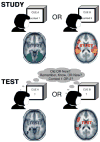The ghosts of brain states past: remembering reactivates the brain regions engaged during encoding
- PMID: 20063927
- PMCID: PMC2853176
- DOI: 10.1037/a0017937
The ghosts of brain states past: remembering reactivates the brain regions engaged during encoding
Abstract
There is growing evidence that the brain regions involved in encoding an episode are partially reactivated when that episode is later remembered. That is, the process of remembering an episode involves literally returning to the brain state that was present during that episode. This article reviews studies of episodic and associative memory that provide support for the assertion that encoding regions are reactivated during subsequent retrieval. In the first section, studies are reviewed in which neutral stimuli were associated with different modalities of sensory stimuli or different valences of emotional stimuli. When the neutral stimuli were later used as retrieval cues, relevant sensory and emotion processing regions were reactivated. In the second section, studies are reviewed in which participants used different strategies for encoding stimuli. When the stimuli were later retrieved, regions associated with the different encoding strategies were reactivated. Together, these studies demonstrate not only that the encoding experience determines which regions are activated during subsequent retrieval but also that the same regions are activated during encoding and retrieval. In the final section, relevant questions are posed and discussed regarding the reactivation of encoding regions during retrieval.
Figures

Similar articles
-
Episodic Memory Retrieval Functionally Relies on Very Rapid Reactivation of Sensory Information.J Neurosci. 2016 Jan 6;36(1):251-60. doi: 10.1523/JNEUROSCI.2101-15.2016. J Neurosci. 2016. PMID: 26740665 Free PMC article.
-
Reactivation of medial temporal lobe and human V5/MT+ during the retrieval of motion information: a PET study.Brain Res. 2009 Aug 18;1285:127-34. doi: 10.1016/j.brainres.2009.06.025. Epub 2009 Jun 13. Brain Res. 2009. PMID: 19527693
-
Imagery and retrieval of auditory and visual information: neural correlates of successful and unsuccessful performance.Neuropsychologia. 2011 Jun;49(7):1730-40. doi: 10.1016/j.neuropsychologia.2011.02.051. Epub 2011 Mar 9. Neuropsychologia. 2011. PMID: 21396384
-
Hemispheric encoding/retrieval asymmetry in episodic memory: positron emission tomography findings.Proc Natl Acad Sci U S A. 1994 Mar 15;91(6):2016-20. doi: 10.1073/pnas.91.6.2016. Proc Natl Acad Sci U S A. 1994. PMID: 8134342 Free PMC article. Review.
-
Episodic memory meets working memory in the frontal lobe: functional neuroimaging studies of encoding and retrieval.Crit Rev Neurobiol. 2000;14(3-4):165-97. Crit Rev Neurobiol. 2000. PMID: 12645957 Review.
Cited by
-
Reinstatement of item-specific contextual details during retrieval supports recombination-related false memories.Neuroimage. 2021 Aug 1;236:118033. doi: 10.1016/j.neuroimage.2021.118033. Epub 2021 Apr 6. Neuroimage. 2021. PMID: 33836273 Free PMC article.
-
Recollection, familiarity, and content-sensitivity in lateral parietal cortex: a high-resolution fMRI study.Front Hum Neurosci. 2013 May 23;7:219. doi: 10.3389/fnhum.2013.00219. eCollection 2013. Front Hum Neurosci. 2013. PMID: 23734122 Free PMC article.
-
Brain networks underlying episodic memory retrieval.Curr Opin Neurobiol. 2013 Apr;23(2):255-60. doi: 10.1016/j.conb.2012.11.005. Epub 2012 Dec 1. Curr Opin Neurobiol. 2013. PMID: 23206590 Free PMC article. Review.
-
Neural similarity between encoding and retrieval is related to memory via hippocampal interactions.Cereb Cortex. 2013 Dec;23(12):2818-28. doi: 10.1093/cercor/bhs258. Epub 2012 Sep 11. Cereb Cortex. 2013. PMID: 22967731 Free PMC article.
-
Cortical reinstatement mediates the relationship between content-specific encoding activity and subsequent recollection decisions.Cereb Cortex. 2014 Dec;24(12):3350-64. doi: 10.1093/cercor/bht194. Epub 2013 Aug 6. Cereb Cortex. 2014. PMID: 23921785 Free PMC article.
References
-
- Anderson JR. Retrieval of propositional information from long-term memory. Cognitive Psychology. 1974;5:451–474.
-
- Anderson JR. The architecture of cognition. Cambridge, MA: Harvard University Press; 1983.
-
- Anderson JR, Bower GH. Human associative memory. Mahwah, NJ: Erlbaum; 1973.
-
- Anderson JR, Reder LM. The fan effect: New results and new theories. Journal of Experimental Psychology. 1999;128:186–197.
Publication types
MeSH terms
Grants and funding
LinkOut - more resources
Full Text Sources
Medical
Miscellaneous

